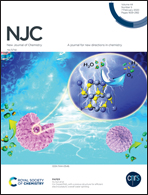The effects of surfactant in the sol–gel synthesis of CuO/TiO2 nanocomposites on its photocatalytic activities under UV-visible and visible light illuminations
Abstract
Effective and low-cost CuO/TiO2 nanocomposite photocatalysts were prepared at room temperature via a surfactant-assisted sol–gel method using titanium(IV) isopropoxide and copper(II) nitrate as precursors. In the current study, a surfactant, namely hexadecyltrimethylammonium bromide, was used in the sol–gel method to reduce the agglomeration of CuO/TiO2 nanocomposites. The framework substitution of CuO in the TiO2 nanostructure was established by different characterization techniques, including XRD, TEM and HRTEM, and the results confirmed that CuO and TiO2 bound one over the other and forming a nanocomposite nature. The optical properties revealed extended tailing of the absorption edge toward the visible region upon CuO doping. CuO serves as the electron reservoir by receiving electrons from TiO2, which suppresses the recombination of e−/h+ and transfers the received electrons to split water, resulting in enhanced photocatalytic activity. The concentration of CuO in the TiO2 nanostructure was fine-tuned to improve the photocatalytic activities. The synergy between CuO and TiO2 was optimum at a concentration of 0.5 wt% CuO. The optimized product produced a promising hydrogen evolution of 1634 μmol g−1 under illumination from UV and visible light sources. The optimized product also showed promising photocatalytic degradation of Rhodamine B dye and better photochemical reduction of Cr6+ under sunlight and UV light than those with other CuO ratios.



 Please wait while we load your content...
Please wait while we load your content...